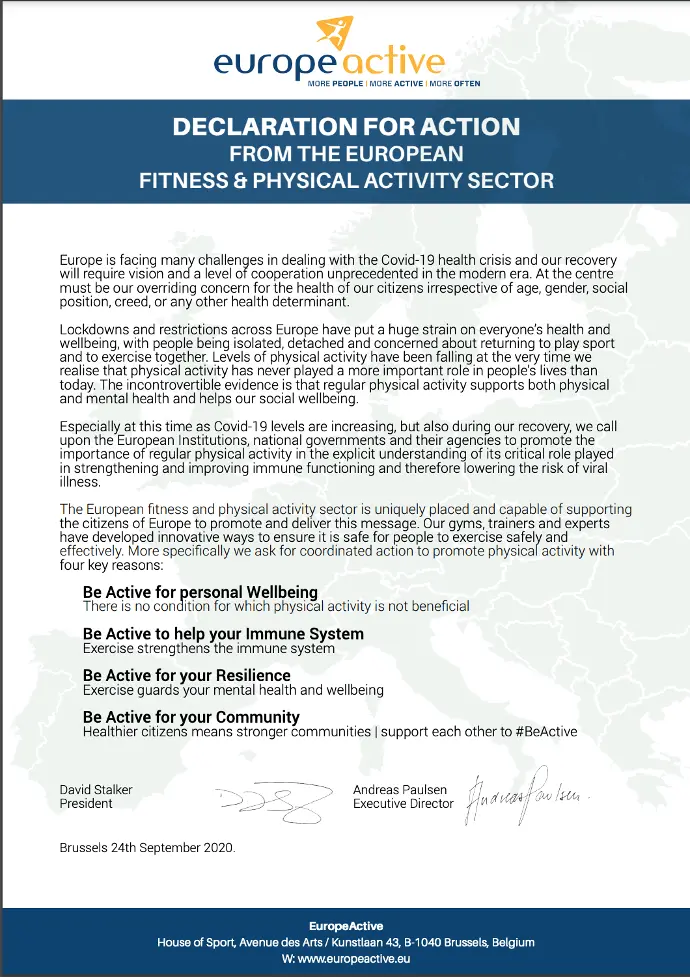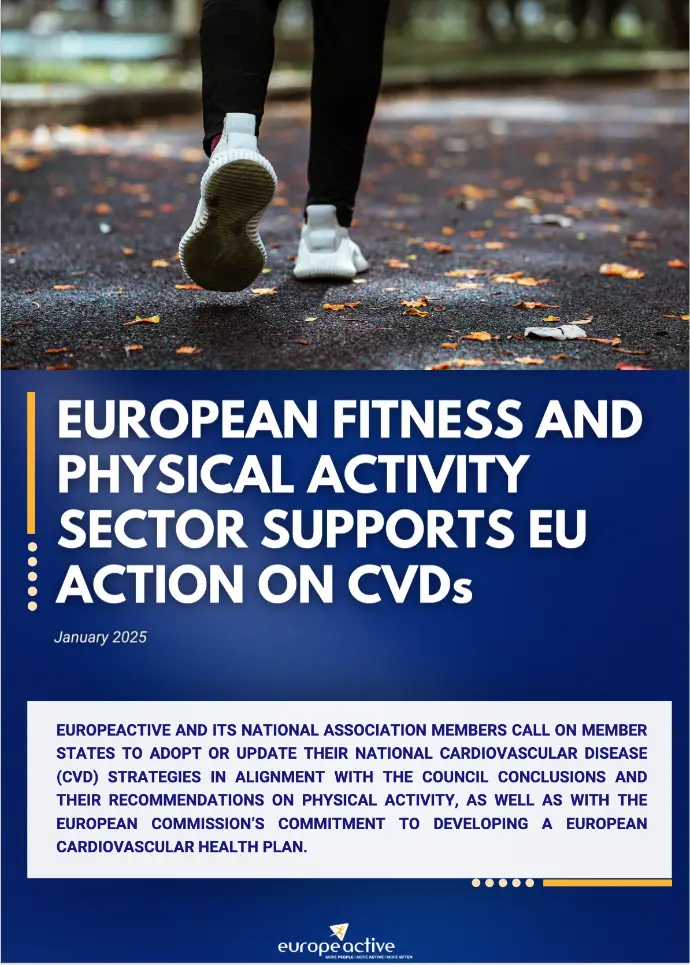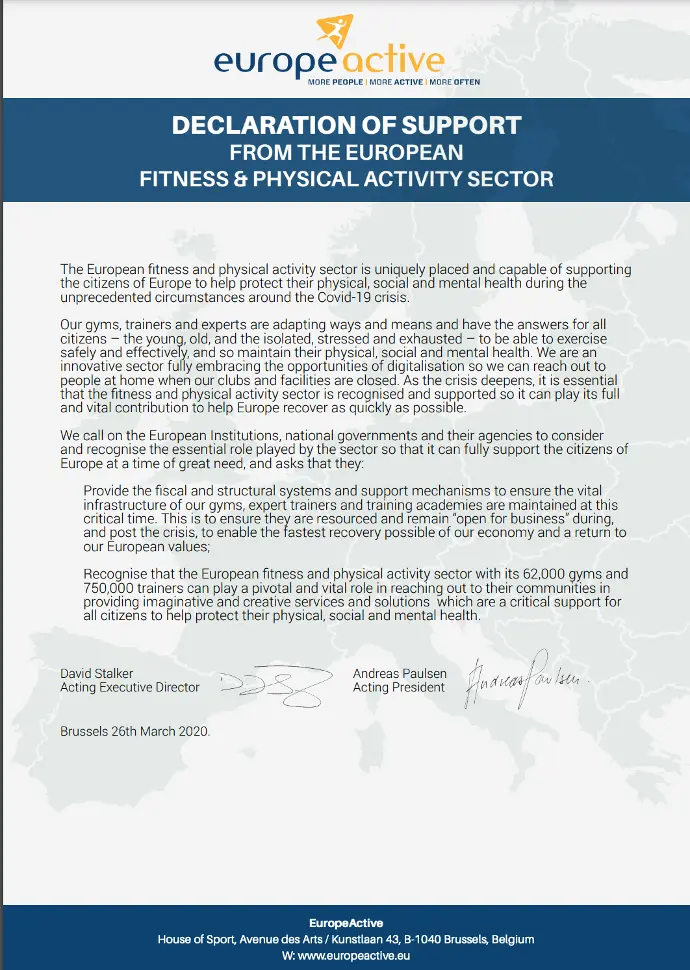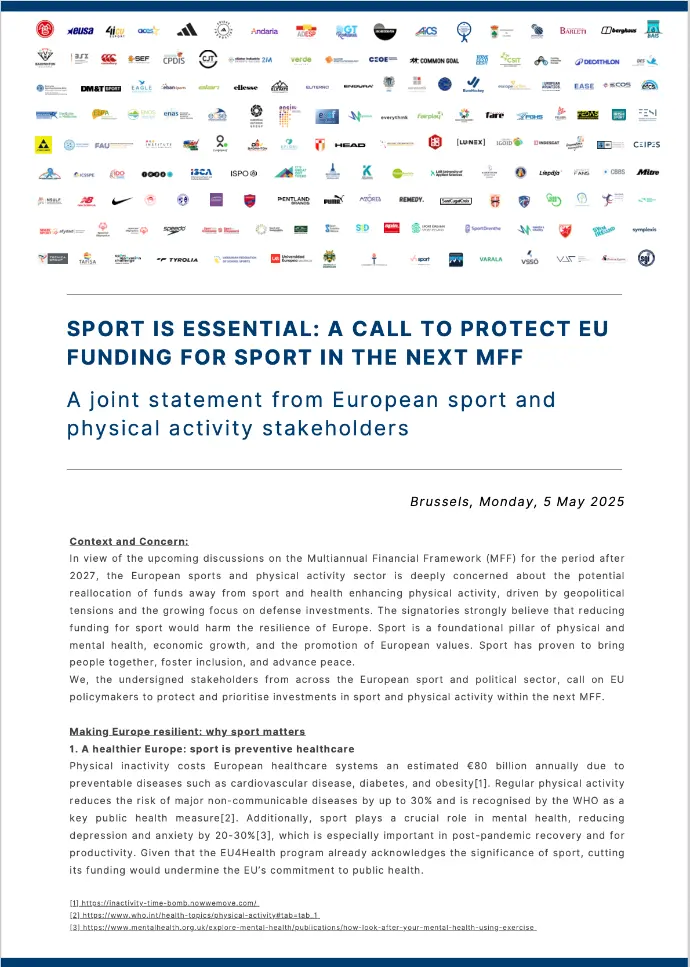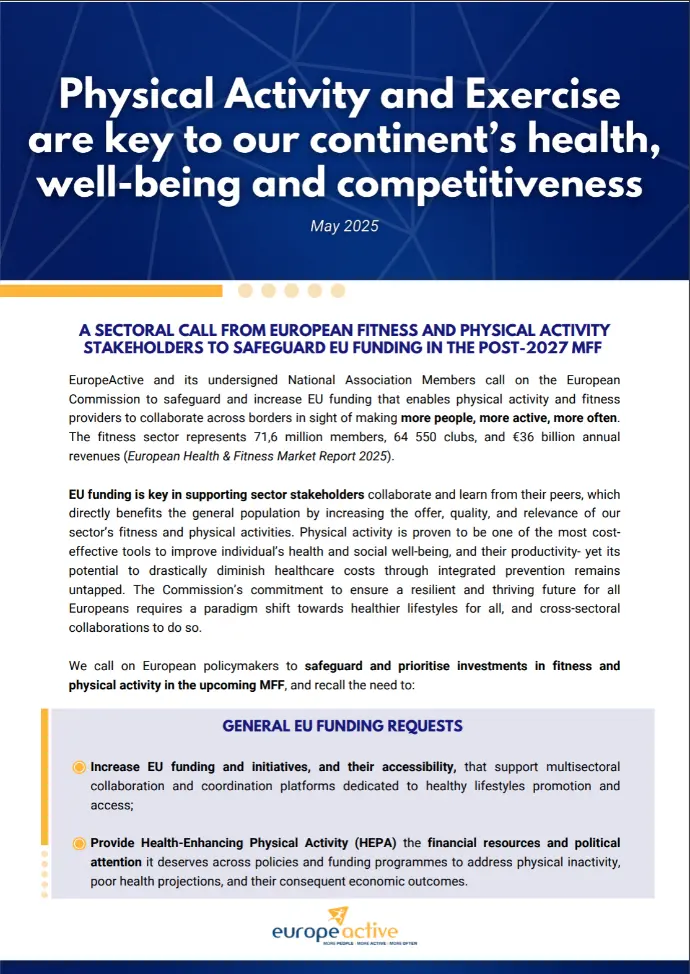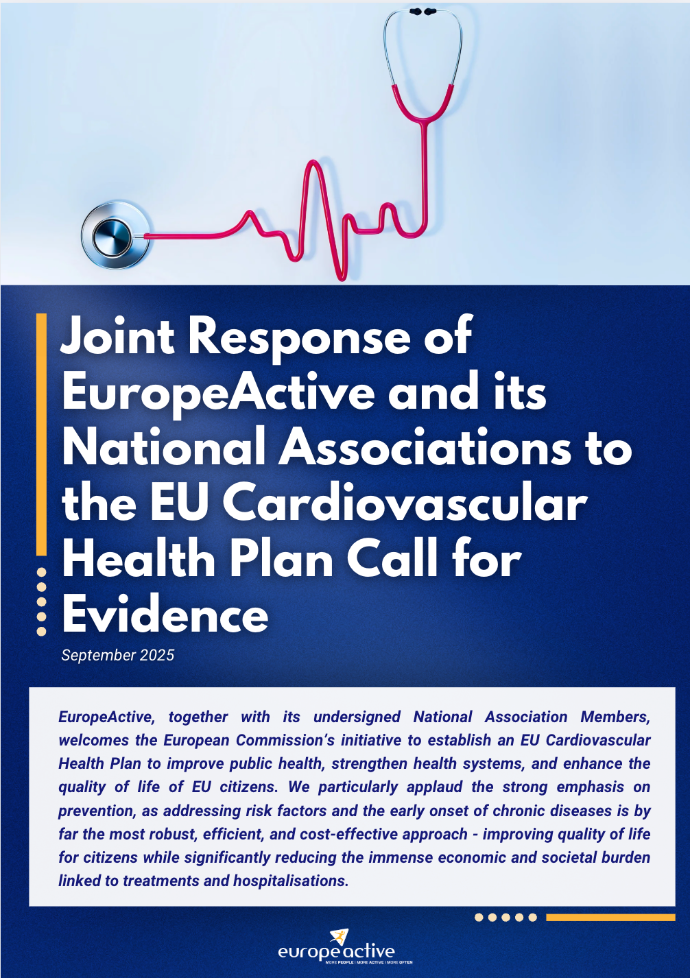EuropeActive Papers
To help inform our members and stakeholders, the EuropeActive EU Affairs Team have developed a series of position and information papers on main policy areas which directly affect the fitness sector.
These papers may be downloaded by clicking the relevant link below.
To help inform our members and stakeholders, the EuropeActive EU Affairs Team have developed a series of position and information papers on main policy areas which directly affect the fitness sector.
These papers may be downloaded by clicking the relevant link below.
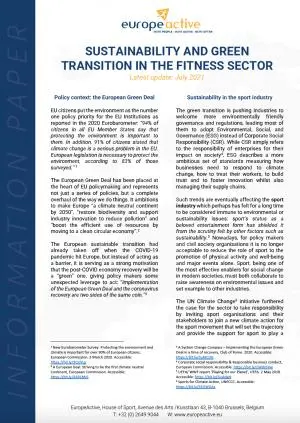
Sustainability and Green Transition in the Fitness Sector
The European Green Deal has been placed at the heart of EU policymaking and ambitions to make Europe “a climate neutral continent by 2050”, pushing the sports industry to adopt more environmentally friendly governance and regulations, and influencing the European fitness and physical activity sector to take responsibility in green and sustainable issues.
Download Here
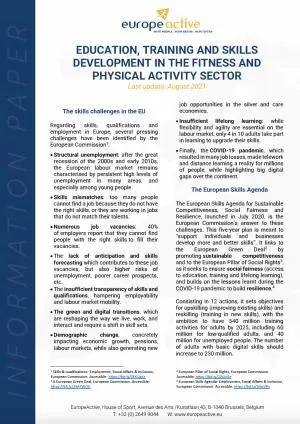
Education, Training and Skills Development in the Fitness and Physical Activity Sector
This information paper looks at the current pressing challenges in the areas of education, training and skills in Europe, and the European Commission ambitions to address them through the European Skills Agenda, before tackling those issues specifically for the Fitness and Physical Activity Sector.
Download Here
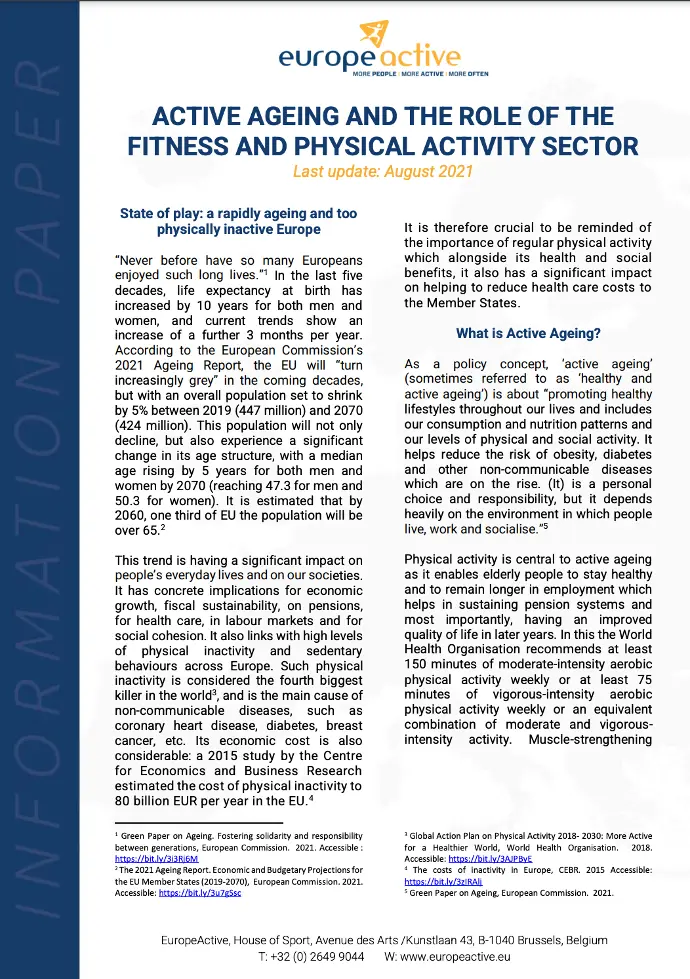
Active Ageing and the Role of the Fitness and Physical Activity Sector
This paper outlines the state of play of European demographics, characterised by a rapidly ageing population. It then explores the concept of ‘Active Ageing’ and the role the fitness and physical activity sector can play to support healthy lifestyles for elderly Europeans.
Download Here
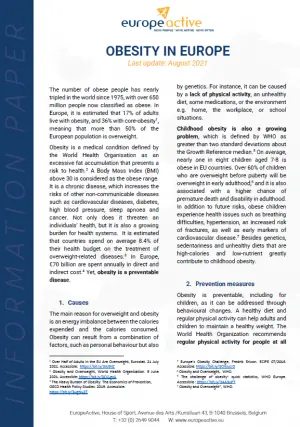
Obesity in Europe
The number of obese people has nearly tripled in the world since 1975, with over 650 million people now classified as obese. Obesity is a chronic disease defined by the World Health Organisation as an excessive fat accumulation that presents a risk to health. Yet, it is a preventable disease, including through regular physical activity.
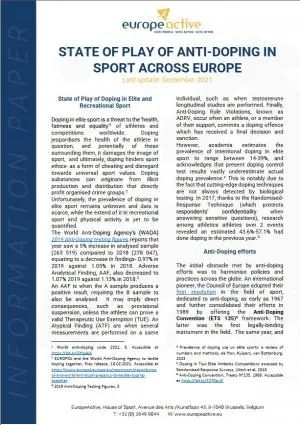
State of Play of Anti-Doping in Sport across Europe
Anti-doping work has traditionally focused on the detection and prevention of doping in elite and competitive sport, notably via National Anti-Doping Organisations (NADOs). In recent years however, it has become generally recognised that doping may be becoming a serious societal and public health threat as it spreads into recreational sport and physical activity.
Download Here
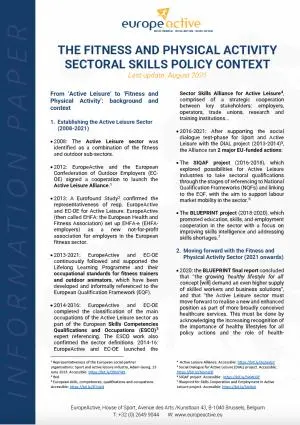
The Fitness and Physical Activity Sectoral Skills Policy Context
The European Fitness and Physical Activity Sector, with 55 million consumers and €18.9 billion revenue, plays a key role in promoting health across Europe. This paper discusses EuropeActive's work in advancing the sector's skills policy.
Download Here
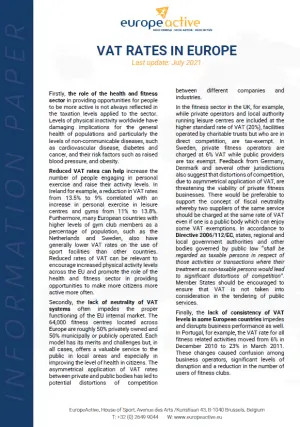
VAT rates in Europe
With over 62,000 facilities and 27 billion Euros of annual revenues, the European health and fitness sector is a significant contributor to taxation revenue across the EU. In regard to rates of VAT applied to our sector across the EU, three central points are worth considering.
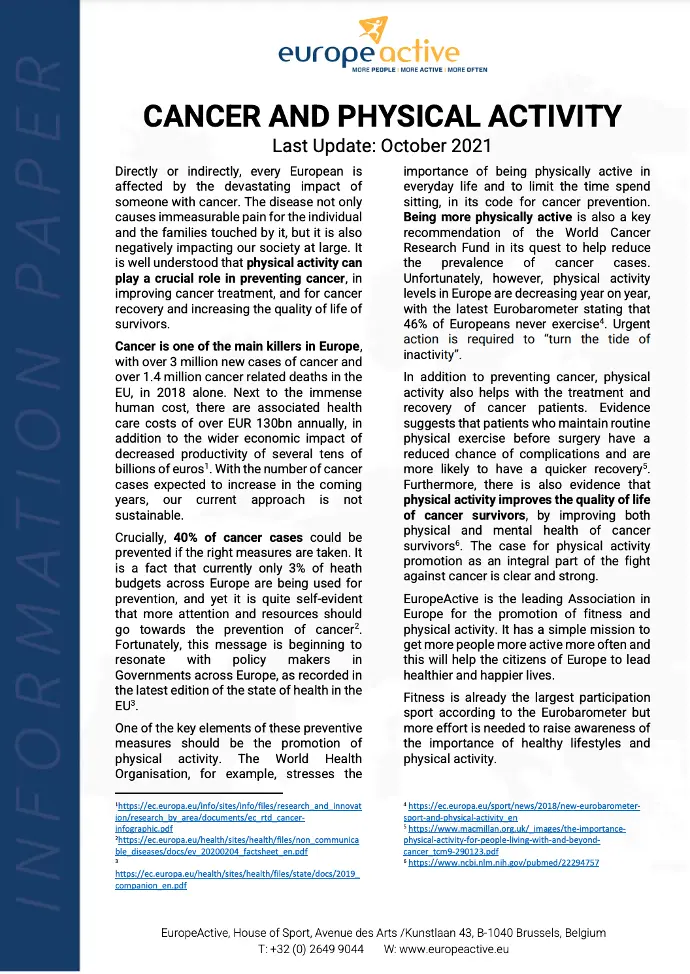
Cancer and Physical Activity
Directly or indirectly, every European is affected by the devastating impact of someone with cancer. The disease not only causes immeasurable pain for the individual and the families touched by it, but it is also negatively impacting our society at large. It is well understood that physical activity can play a crucial role in preventing cancer, in improving cancer treatment, and for cancer recovery and increasing the quality of life of survivors.
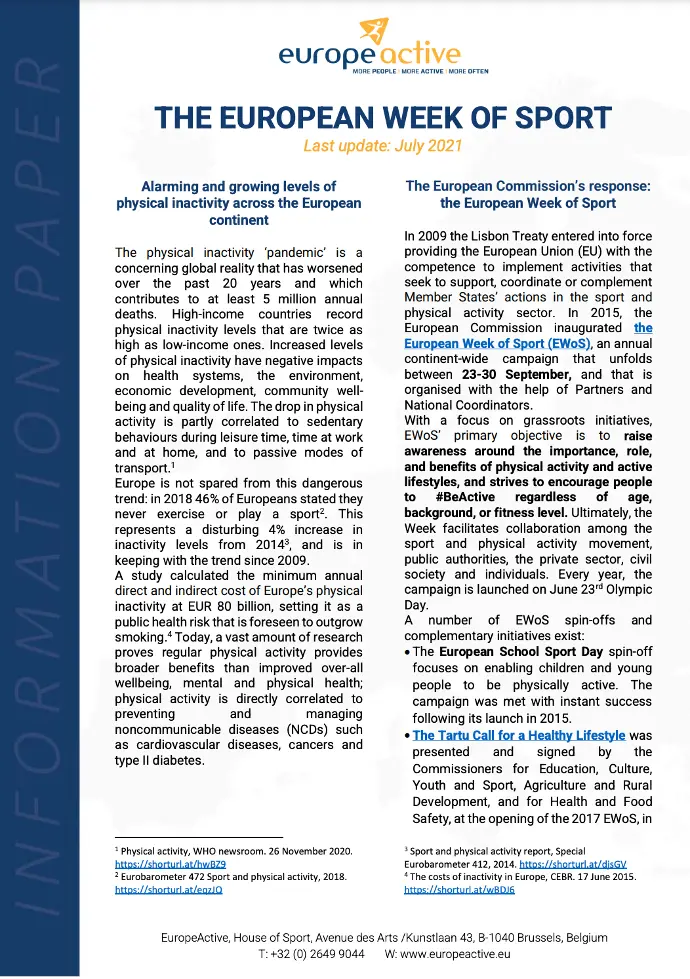
The European Week of Sport
Physical inactivity levels are reaching all-time highs across Europe, which is concerning for individuals, communities, countries, and the European Union. Since 2009, the EU gained competences to promote sport and physical activity, which prompted the European Week of Sport campaign.
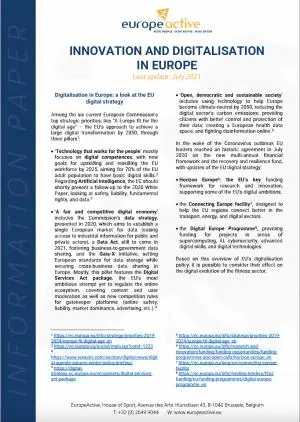
Innovation and Digitalisation in Europe
Digitalisation is rapidly and deeply transforming all areas of our society and economy, and in Europe the fitness sector is no exception. In recent years, a wide range of innovative technologies and online solutions have been developed for physical activity. For its part, the EU has an ambition to achieve a large digital transformation by 2050.
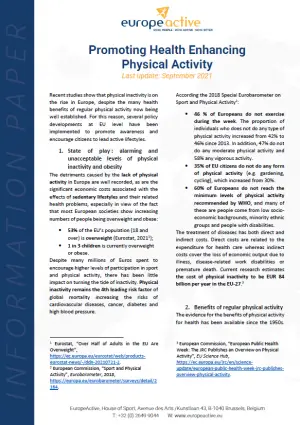
Promoting Health Enhancing Physical Activity
The detriments caused by the lack of physical activity in Europe are well recorded, as are the significant economic costs associated with the effects of sedentary lifestyles and their related health problems, especially in view of the fact that most European societies show increasing numbers of people being overweight and obese.
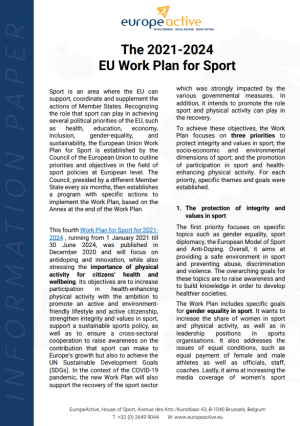
EU WORK PLAN FOR SPORT (2021-2024)
The fourth Work Plan for Sport for 2021-2024 , running from 1 January 2021 till 30 June 2024, focuses on antidoping and innovation, while also stressing the importance of physical activity for citizens’ health and wellbeing.
EuropeActive is delighted to share the following guidance documents.

Critically rethinking for succesful reopening of the european fitness and physical activity sector
In 2019 EuropeActive started the process of writing a new strategy for 2020-2025 with a plan to launch and present this to members at the European Health and Fitness Forum in April 2020. By mid-March the world was in turmoil because of the Covid-19 pandemic, which meant that the EuropeActive Team had to shift gear and focus on informing and assisting the sector to safely operate through and eventually come out of the lockdown.

Summary of current recommended practices for operating under Covid-19 restrictions
National laws, guidance, regulations and restrictions must be observed and respected at all times.
Notice, This is general guidance only for consideration by operators when re-opening their facility. It does not include swimming pools, saunas, spa areas, or outside activities. National conditions may apply and alter this guidance.

Thoughts on Covid-19“BC versus AC”
This is the 4th article in the Post Covid series written by Herman Rutgers, EuropeActive Ambassador with David Stalker, EuropeActive President.In this article, a perspective on the trends that will affect fitness operators will be shared and some thoughts that will enable them to thrive in the “next normal” will be discussed.
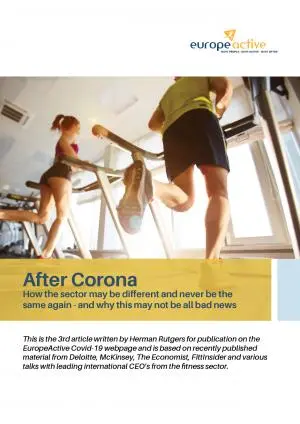
After Corona - How the sector may be different and never be the same again - and why this may not be all bad news
This is the 3rd article written by Herman Rutgers for publication on the EuropeActive Covid-19 webpage and is based on recently published material from Deloitte, McKinsey, The Economist, FittInsider and various talks with leading international CEO’s from the fitness sector.

Leveraging online learning
Traditional learning has historically been based within a physical classroom environment where groups of people can learn in real-time together. There are many benefits to this type of learning environment which is why it has persisted for so long. However, it is certainly not the only way to support the learning process.

Creating an online learning alternative
Teaching and learning in an online environment shift the traditional teacher-student relationship. From a teacher’s perspective, their ability to deliver against learning outcomes will not only depend on their ability to deliver content but also on the learner and their own capacity to work with available technological resources. This skill will in turn be determined by levels of experience and comfort with the use of these resources. This underlines the importance of tutor training, learner inductions, orientations as well as, tech support in any e-learning provision.

The Corona Virus (Covid-19): how it impacts fitness operators’ short term and some thoughts to restart stronger!
The Corona virus pandemic is now creating unprecedented issues for the global fitness industry. However, we are sure that we can all together as an industry overcome such difficult situation. Behind any difficulty lies an opportunity: the club operators can use the present time to adopt different strategies and think how to serve their customers in new ways introducing, for example, more digital training solutions.In Europe, we are later in the curve than China/Asia Pacific. The purpose of this paper is to highlight what can we have learned from their experiences so far.

Raising the digital profile of your Business - Creating member value with digitalisation...
Focus on your members and create value in a highly connected digital worldFitness facilities have a unique opportunity to keep their community engaged with activities and help them be healthy and happy through what is becoming a challenging set of circumstances surrounding the global spread of COVID-19. With a large number of fitness facilities choosing to proactively encourage social distancing or close their doors for the health and safety of their members and communities, we feel there is a real opportunity to fortify relationships with members, re-establish healthy routines and practices, and develop your companies’ brand mission by making good use of the digital tools available to you.
In a sign of solidarity for our national associations and other key stakeholder EuropeActive has published various declarations which call upon the European Institutions, national governments and their agencies to promote the importance of regular physical activity and asks for their coordinated action with our sector to promote the importance of physical activity.
To be successful your content needs to be useful to your readers.
Our Sectoral Manifesto

In a sign of solidarity for our national associations and other key stakeholder EuropeActive has published 2 declarations which call upon the European Institutions, national governments and their agencies to promote the importance of regular physical activity and asks for their coordinated action with our sector to promote the importance of physical activity.
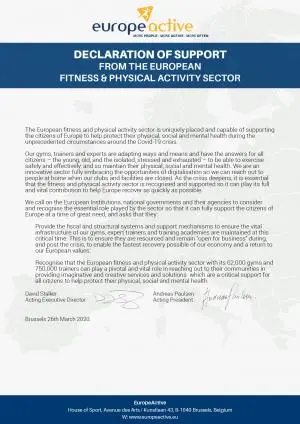
Declaration of Support
EuropeActive calls on the European Institutions, national governments and their agencies to consider and recognise the essential role played by the sector in supporting the citizens of Europe to help protect their physical, social and mental health during the unprecedented circumstances around the COVID-19 crisis.
Download Here
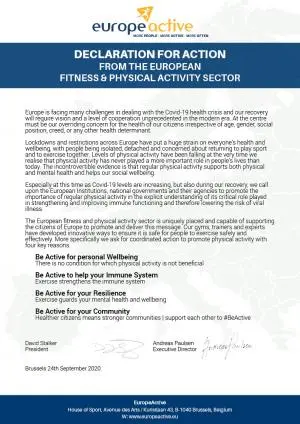
Declaration of Action
EuropeActive calls upon the European Institutions, national governments and their agencies to promote the importance of regular physical activity and asks for coordinated action to promote physical activity.
In a sign of solidarity for our national associations and other key stakeholder EuropeActive has published 2 declarations which call upon the European Institutions, national governments and their agencies to promote the importance of regular physical activity and asks for their coordinated action with our sector to promote the importance of physical activity.

Declaration of Support
EuropeActive calls on the European Institutions, national governments and their agencies to consider and recognise the essential role played by the sector in supporting the citizens of Europe to help protect their physical, social and mental health during the unprecedented circumstances around the COVID-19 crisis.
Download Here

Declaration of Action
EuropeActive calls upon the European Institutions, national governments and their agencies to promote the importance of regular physical activity and asks for coordinated action to promote physical activity.
